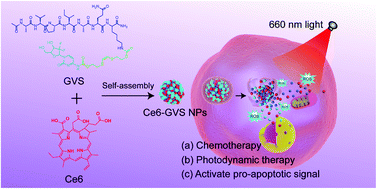A nanomedicine enables synergistic chemo/photodynamic therapy for pancreatic cancer treatment†
Abstract
Pancreatic cancer is one of the leading causes of cancer-related deaths worldwide. Gemcitabine (Gem) has been a key chemotherapy agent for pancreatic cancer treatment by suppressing cell proliferation and inducing apoptosis. However, the overexpression of inhibitors of apoptosis (IAP) family of proteins during the carcinogenesis of pancreatic cancer can develop resistance to chemotherapy treatment and result in poor efficacy. To achieve the synergistic combinations of multiple strategies for this dismal disease, we developed a robust nanomedicine system, consisting of a photodynamic therapeutic agent (chlorine e6, Ce6) and a pro-apoptotic peptide–Gem conjugate. To have spatiotemporally controlled drug release, the pro-apoptotic peptide–Gem conjugate was designed to have a vinyldithioether linker that was sensitive to reactive oxygen species (ROS). The nanomedicine was fabricated by the direct self-assembly of the pro-apoptotic peptide–Gem conjugate with Ce6. After being delivered into tumors, the nanomedicine disassembled and rapidly released Gem, Ce6, and the pro-apoptotic peptide upon light illumination (660 nm). Both in vitro and in vivo studies in pancreatic cancer models confirmed the tumor inhibition efficacy with low systemic toxicity to animals.



 Please wait while we load your content...
Please wait while we load your content...